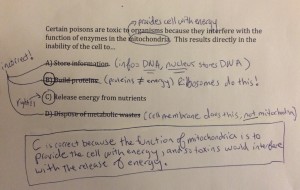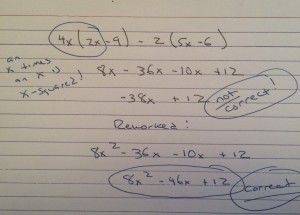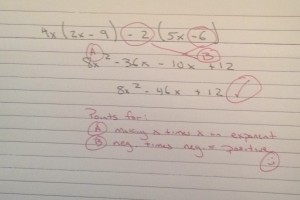02.03.16More on the Unheralded but Highly Effective Technique #10: Own and Track
During a recent lesson, Vicki Hernandez, an 8th grade biology teacher at Troy Prep in Troy, NY, asked her students to answer this question about cell respiration:
Certain poisons are toxic to organisms because they interfere with the function of enzymes in the mitochondria. This results directly in the inability of the cell to…
A) Store information
B) Build proteins
C) Release energy from nutrients
D) Dispose of metabolic wastes
The correct answer is “C,” but students struggled to answer- only about half knew C was correct and at least one student guessed that each of the answer choices was right. So Vicki decided to spend some time analyzing error: she didn’t just want her students to know what the right answer was, though, she wanted them to know why. And even more than that she wanted them to understand what was wrong with the answers that were incorrect. So the class reviewed the role of the mitochondria and how enzymes worked within it, and then they studied each wrong answer to unpack why it could not be correct. Students should have realized, for example, that the mitochondria does not have a role in disposing waste from the cell. That would make answer D implausible, and analyzing why helps students fill in the gaps in their misunderstanding of cell structure and function.
Studying wrong answers like Vicki did is an example of Excavate Error (Technique 9), and time spent on error analysis is often a worthy investment. But it was doubly worthwhile in this case because of something Vicki added at end of the process- a technique we call Own and Track, in which she not only asked her students to study their errors, but to annotate what they learned from that process. This helped them to lock in the learning and gave them a record of it that they could refer to later on.
Think for a moment of how important that is. To have spent perhaps 10-15 minutes reviewing the question is a big investment. Would students remember it? This is a critical question to ask because research suggests that students sometimes fail to distinguish in their memory right answers from wrong when they have heard both. They remember the deep discussion about the mitochondria and waste but don’t recall whether that was because the mitochondria play a role in disposing it or didn’t Here’s the kicker, the lower performing the student the more likely he or she is to retain misinformation from teaching.
Below you can see what one student’s notes looked like after both error analysis and Own and Track in Vicki’s class. As you can see, she asked her students to annotate the process of error analysis. Note: we have transcribed the student’s work to assist with legibility but the content of the mark-up is his:

In writing about Own and Track for the forthcoming Field Guide, Joaquin Hernandez, Jen Kim and I distilled four ways teachers can help students lock in the learning after error analysis. You can see several of these in our example.
- Locking down the “right” answer
- Revising and improving original work
- Thinking metacognitively about wrong answers.
- ‘Meta-‘ works for right answers, too.
- Locking down the “right” answer
If research suggests that students are as likely to remember what they did wrong as what they did right when solving a problem, then failing to clearly distinguish wrong from right, means running the risk that students will come away fuzzy about what correct the correct answer was. So after you analyze error, make sure students have distinguished the correct answer from the alternatives. For example, you can ask students to label answers as “correct” or “not correct,” have them cross out wrong responses and circle correct ones, or mark answers up with notes, perhaps even in different colored ink.
- Revising and improving original work
After a thorough discussion of right and wrong answers, it’s critical to ask students to use what they learned to improve their work. This helps them remember and is also a useful way to gauge how well you addressed misconceptions. If students can readily apply what they learned to improve their work, it’s a positive indicator that they are on the path to mastery. But if they struggle to do so, you may want to resume the discussion or gather more data via observation to properly diagnose the root of the struggle.
We’ve provided an example below from a math class. It shows what those first two steps might look like: The student got the original problem wrong (in black ink) and then re-worked it correctly (in blue). He noted his mistake and clearly distinguished right from wrong.

- Thinking metacognitively about wrong answers
The more you invest in the process of excavating, the more crucial it is for students to mark up and reflect on how these corrections and revisions improved their work. That means creating a written record of the process and thinking that led them to “right.” From there, they can study and apply what they learned to similar work- again and again. In our math problem above the student circles the precise location of his error. He then tags his correction with a clear label that captures in specific terms what he should have done differently (an x times an x is x-squared!).
- Meta- works for right answers, too
Reflecting on what worked is also important. As the second example below shows, it can help to have students identify precisely where they did correct work and what made it correct. In this instance, the teacher asked a student to circle key points that led to the right answer. Then he pushed students further by asking them to “footnote” those points with explanations of the thinking. This system for notation provides students with sufficient space to fully articulate why the work was correct without crowding out the work itself.

There’s lots more to reflect on in Own and Track. Check out our full update in the Teach Like a Champion 2.0 Field Guide, due out in August.

In my own teaching, I have always been one that favored students finding their errors and learning the WHY of why they went wrong. I never considered that this might in turn make them struggle with what was correct. The Own and Track technique would be great for students who may need to see the process several times before understanding the correct way of getting the answer. I can see this especially helpful for students who struggle with the concepts. I use the Teach Like a Champion with all of my new teachers because the techniques that are introduced are easy for the teacher to master, and take such little time to incorporate into the classroom.